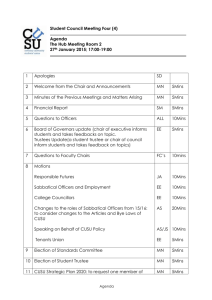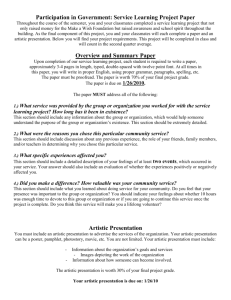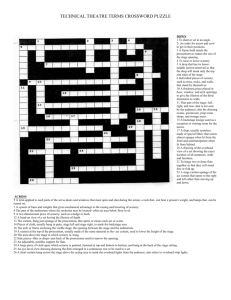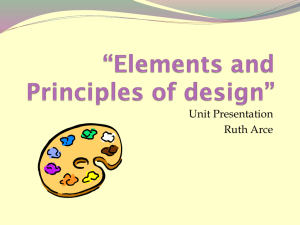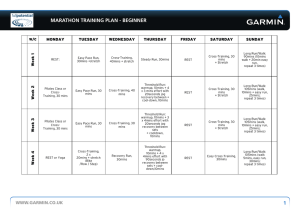File - Lauren Grover
advertisement
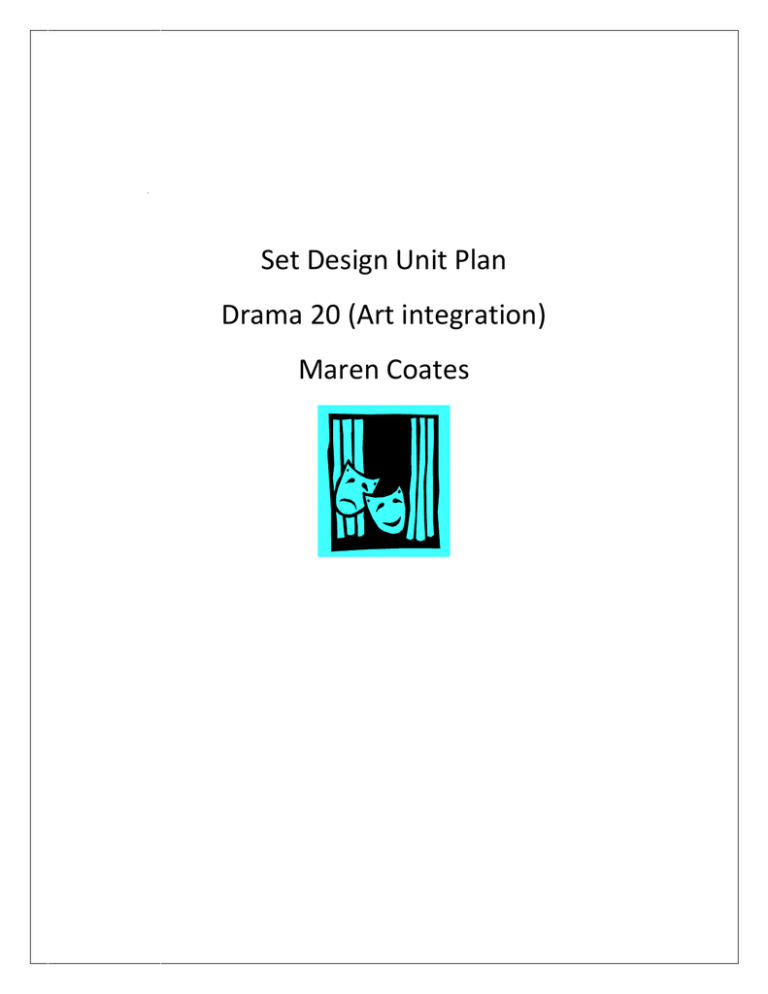
Set Design Unit Plan Drama 20 (Art integration) Maren Coates Set Design Rationale This unit is a focus on the designing process of creating stage scenery with some exploration into the different styles of creating mood and symbolism through the creation of flats and ground paint. This unit encourages students to look at themselves as creative artists to strengthen their confidence in making artistic decisions and sticking to it. Students begin to analytically look at their own ideas and learn how to expand on their ideas to create a world that matches their artistic decision in every aspect. Students will learn to problem solve as they attempt to be consistent in atmospheric moods and themes throughout this unit. Drama Objectives Art Objectives Students will… Students will… 1. Understand the purpose of using sets. 2. Understand the importance of effectively using illusion in set design. 3. Understand the function of artistic unity. 4. Use the correct terminology in talking about proscenium stages. 5. Know safety procedures implemented around set construction. 6. Be familiar with the various types of stages. 7. Demonstrate knowledge of symbolism and its psychological implications (colour, line, texture, mass, form). 8. Know the difference between different types of sets (bare stage, curtain set, drop and wing set, box set, unit set, suggestive or selective set, flats, projections, scrims, -Work with personal modes of expression. - Select themes that can provide inspiration for expressive style investigations. - Will understand that viewing many styles or artistic movements will develop their ability to critique their work and others. -Understand that discussing the compositions effectiveness is a step in interpreting one’s own artwork. - Work with different possibilities and limitations of different materials to develop Imagery. cyclorama.) 9. Correctly make scale drawings. 10. Demonstrate understanding and use of ground plans. 11. Demonstrate understanding of scenery placement. Lesson Summaries Lesson 1 Hand out unit outline to students. Students will be shown examples of different types of stages. Students will then think, pair, share about the pros and cons of each type of stage. Pick Play Lesson 2 Introduce the concept of Artistic Unity show examples. Discuss symbolism and mood. Students pick a scene from their chosen play. Students decide on the mood and style. Lesson 3 Ground Plans. What is scale drawing? Practice drawing ground plans. Draw stage to scale. Create ground plan for scene. Students will then Mix & match types of scenery definitions. Show examples of each type of scenery. Placement of scenery. Lesson 4 Illusions & textures. Intro to flat painting techniques. Experiment with creating paint textures and illusions. Decide on style for a flat in the scene and the paint for the floor. Lesson 5 Students receive time to finish their floor and flat sample and wrap up project loose ends. Students will write their defense paper. Drama Essential Questions Art Essential Questions Date: Period:(Lesson 1) Grade: 11 Unit: Tech: Set Design Maren Coates Length: 80mins OBJECTIVES LESSON OBJECTIVES: Understand the purpose of using sets. Use the correct terminology in talking about proscenium stages Be familiar with the various types of stages. Will understand that viewing many styles or artistic movements will develop their ability to critique their work and others. ASSESSMENT -Think, Pair Share (teacher observation) MATERIALS -Outlines -Scripts -Powerpoint -Sticky notes INTRO - Handout Unit Outline- Have students read through and ask any question they may have about the unit. (10mins) BODY Activity 1-Show the students different types of stages Theatre in the Round (riverside community players) Proscenium Theatre Ask the students what makes these two theatres fundamentally different? (10mins) Activity2- Show a powerpoint with examples of all types of stages. With a partner have the students think, pair, and then share with the class about what the pros and cons of each stage might be. (15mins) Activity 3- Tell students that they need to pick a play that they will base the rest of their set assignments on for the unit. (5mins) Activity 4- Have students look through scripts and pick a play (35mins) CLOSURE - Ask students to write their name on a sticky note, put the sticky note on the script they have chosen and hand the script in. (5mins). SPONGE -Have Students get together with a partner and share their top two scenes picks in their plays. REFLECTION Date: Period:(Lesson 2) Grade: 11 Unit: Tech: Set Design Maren Coates Length: 80mins OBJECTIVES LESSON OBJECTIVE: Understand the function of artistic unity. Demonstrate knowledge of symbolism and its psychological implications (colour, line, texture, mass, form). Work with personal modes of expression. Select themes that can provide inspiration for expressive style investigations. Understand that discussing the compositions effectiveness is a step in interpreting one’s own artwork. ASSESSMENT -Small group discussion MATERIALS -Scripts -Set Picture INTRO Both of these sets are for the same play. Why are they different? What makes them different? Have students (10mins) BODY Activity 1- Look through the Director’s Kaleidescope –Find pictures of actual sets and print them out onto large pieces of paper in colour. Break students into groups and they go to a “set design station” which has one of the pictures. Underneath the picture leave a bit of space for the student’s to add their thoughts about mood, atmosphere, any other elements of drama or elements of design. (30mins) Activity 2- Pick scene- Have students grab their scripts and pull out a blank piece of paper. Tell students they have half an hr to narrow it down to their top two scenes, use the blank piece of paper to brainstorm and sketch, choose their scene and decide what sort of a mood the want to create. (35mins) CLOSURE - Have students return their scripts back to you. (5mins) SPONGE -With a partner brainstorm set ideas for your scenes. REFLECTION Date: Period: (Lesson 3) Maren Coates Grade: 11 Unit: Tech: Set Design Length: 80mins OBJECTIVES LESSON OBJECTIVE: Know the difference between different types of sets (bare stage, curtain set, drop and wing set, box set, unit set, suggestive or selective set, flats, projections, scrims, cyclorama.) Correctly make scale drawings. Demonstrate understanding and use of ground plans. Work with different possibilities and limitations of different materials to develop Imagery. Understand that discussing the compositions effectiveness is a step in interpreting one’s own artwork. ASSESSMENT -Sample ground plans -Scene ground plan MATERIALS -Scripts -Terms and Definitions -Large sheets of paper -Rulers INTRO purpose in theatre? (5mins) What is this? What is its BODY Activity 1-. Ground Plans- Show the ground plan powerpoint and discuss how to draw a ground, what sort of scenery is reasonable for different stage types. Have the students take notes to remember drawing symbols.(15mins) Activity 2-Practice ground plans- have the students practice creating ground plans. Use the four ground plans at the end of the powerpoint. (20mins Activity 3- In small groups or partners give the students either a card with a scenery Term or Definition on it have the students wander around the room trying to find the group with the term or definition that matches theirs. Then have them read it out.(10mins) Activity 4-Show examples of each types of scenery and discuss placement of scenery and balance. (5mins) Activity 5- Have students create a scale drawn stage ground plan of their scene on a large piece of paper. (20mins) CLOSURE - Have students hand in their groundplan (5mins) SPONGE - Have students start thinking about colours and themes for their set to match their choice of mood. REFLECTION Date: Period: (Lesson 4) Grade: 11 Unit: Tech: Set Design Maren Coates Length: 80mins OBJECTIVES LESSON OBJECTIVE: Understand the importance of effectively using illusion in set design. Understand the function of artistic unity. Demonstrate knowledge of symbolism and its psychological implications (colour, line, texture, mass, form). Select themes that can provide inspiration for expressive style investigations. Work with personal modes of expression. Work with different possibilities and limitations of different materials to develop Imagery. Will understand that viewing many styles or artistic movements will develop their ability to critique their work and others. ASSESSMENT -Paint Samples MATERIALS -Scripts -small canvas -paint -brushes INTRO pictures Have students look at these sets. What illusions are being portrayed? (dirt, grime, stone, brick, sky, shadows) How are they done?(10 mins) BODY Activity 1-.Introduce to the students different types of painting techniques for painting set pieces and creating illusions (cross-hatching, scumbling, spattering, feather dusting, dry-brush, stenciling)http://www.youtube.com/watch?v=422t4dodQSM,http://schooltheatre.org/education/maki ng/painting-scene (20mins) Activity 2- Students will each be given a couple canvas’ to try each style of painting, and experiment with colours. (20mins Activity 3- Students will decide on a style and colours for one flat in their scene and what the floor will look like and paint a canvas to look like such. (20mins) CLOSURE - Get students to clean up paint and messes.(10mins) SPONGE -.N/A REFLECTION Date: Period: (Lesson 5) Grade: 11 Unit: Tech: Set Design Maren Coates Length: 80mins OBJECTIVES LESSON OBJECTIVE: Demonstrate understanding of scenery placement. Know the difference between different types of sets (bare stage, curtain set, drop and wing set, box set, unit set, suggestive or selective set, flats, projections, scrims, cyclorama.) Understand the purpose of using sets. Understand the function of artistic unity. Understand the importance of effectively using illusion in set design. Use the correct terminology in talking about proscenium stages. Be familiar with the various types of stages. Demonstrate knowledge of symbolism and its psychological implications (colour, line, texture, mass, form). Work with personal modes of expression. Select themes that can provide inspiration for expressive style investigations. Work with different possibilities and limitations of different materials to develop Imagery. Understand that discussing the compositions effectiveness is a step in interpreting one’s own artwork. ASSESSMENT - Floor and Flat Sample, Defense paper MATERIALS -Scripts -Paint -Brushes -canvas -computer room INTRO What has been added to these stone paintings to make them look real?(5mins) BODY Activity 1-.Give the students a quick reminder of all the things that they need to accomplish by the end of the class such as both flat and floor samples and if they aren’t finished their defense paper it’s for homework (10mins) Activity 2-Give students the rest of the time to work. (55mins CLOSURE -.Have students clean up and hand things in. (10mins) SPONGE -.N/A REFLECTION
